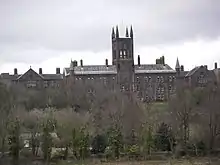| Lancaster Moor Hospital | |
|---|---|
 The 1816 building in 2008 | |
 Location in Lancaster | |
| Geography | |
| Location | Lancaster, Lancashire, England |
| Coordinates | 54°02′56″N 2°46′19″W / 54.049°N 2.772°W |
| Organisation | |
| Type | Specialist |
| Services | |
| Speciality | Psychiatry |
| History | |
| Former name(s) | Lancashire County Lunatic Asylum (1816-1930) Lancaster County Mental Hospital (1930-1948) |
| Opened | 1816 |
| Closed | 2000 |
Listed Building – Grade II* | |
| Official name | Moor Hospital, Blocks 40, 41, 42, 44 and 46 |
| Designated | 24 January 1994 |
| Reference no. | 1289436 |
Listed Building – Grade II | |
| Official name | Moor Hospital, New Block |
| Designated | 24 January 1994 |
| Reference no. | 1195079 |
Listed Building – Grade II | |
| Official name | Boundary walls, railings, gates and gate piers at Lancaster Moor Hospital |
| Designated | 13 September 2006 |
| Reference no. | 1391761 |
Lancaster Moor Hospital, formerly the Lancaster County Lunatic Asylum and Lancaster County Mental Hospital, was a mental hospital in Lancaster, Lancashire, England, which closed in 2000 (the mental health departments left in 1991, but others remained).
History

The main building, which was designed by Thomas Standen, was opened as the First Lancashire County Asylum in 1816.[1] It was extended at various times until 1850, and is grade II* listed.[2] A further building, which was designed by Arnold W. Kershaw in the gothic style and known as "the Annexe", was completed in 1883 and is grade II listed,[3] as are its walls, railings, and gateways.[4] The hospital's chapel, which was designed by Edward Graham Paley, was built in 1866 and is grade II listed.[5]
Campbell House, a facility for paying "gentlemen" patients, was completed in 1909.[6] And the Ladies' Villa, Also Known as Ridge Lea, a facility for paying "lady" patients, was completed in 1916. The Ladies Villa was big enough to be classed as its very own small Mental Asylum.[7]
The hospital was a pioneering site for the humane treatment of the mentally ill with the introduction of treatments such as electroconvulsive therapy (ECT).[8] The writer Alan Bennett describes his mother's treatment in the hospital in his memoirs.[8]
Following the introduction of Care in the Community in the early 1980s, the hospital went into a period of decline and closed in 2000; the Annexe and chapel have since been converted into apartments, and houses have been built in the grounds.[9][10]
The hospital was renamed as Lancashire County Mental Hospital in 1930, and as Lancaster Moor Hospital in 1948.[11]
See also
- Grade II* listed buildings in Lancashire
- Listed buildings in Lancaster, Lancashire
- Prestwich Hospital, the second Lancashire County Asylum
- Rainhill Hospital, the third Lancashire County Asylum
- Whittingham Hospital, the fourth Lancashire County Asylum
- Winwick Hospital, the fifth Lancashire County Asylum
- Calderstones Hospital, the sixth Lancashire County Asylum
References
- ↑ Lewis, Samuel (1848). "'Lambley - Lancaster', in A Topographical Dictionary of England". London: British History Online. pp. 6–17. Retrieved 4 October 2018.
- ↑ Historic England. "Moor Hospital, Blocks 40,41,42,44 and 46 (1289436)". National Heritage List for England. Retrieved 12 February 2023.
- ↑ Historic England. "Moor Hospital, New Block (1195079)". National Heritage List for England. Retrieved 2 July 2014.
- ↑ Historic England. "Boundary walls, railings, gates and gate piers at Lancaster Moor Hospital (1391761)". National Heritage List for England. Retrieved 2 July 2014.
- ↑ Historic England. "Church of St Michael, Moor Hospital (1289454)". National Heritage List for England. Retrieved 2 July 2014.
- ↑ "Lancaster Moor". County Asylums. Retrieved 15 October 2018.
- ↑ "Ridge Lea Asylum". Beyond the point. Retrieved 28 June 2023.
- 1 2 Woodend, Joscelin (18 December 2013). "The Evolution of the Treatment of the Mentally Ill: How Lancaster County Lunatic Asylum Changed the Face of Treatment". New Histories. 5 (2). Archived from the original on 14 July 2014. Retrieved 2 July 2014.
- ↑ Riley, Sue (5 February 2013). "Lancaster's Moor Hospital to be transformed in multi-million pound housing property development". Lancashire Life. Retrieved 2 July 2014.
- ↑ Law, Cally (4 May 2014). "Asylum seekers". Sunday Times. Archived from the original on 14 July 2014. Retrieved 2 July 2014.
- ↑ Watts-Tobin, Mary Ann (1 October 2010). "A history of Lancaster Moor Hospital". Morecambe Bay Medical Journal. 6 (3): 71–74. doi:10.48037/mbmj.v6i3.307.
External links
- "Lancaster Moor Hospital, Lancaster". Hospital Records Database. The National Archives. Retrieved 2 July 2014. Index of locations of records of the hospital
.jpg.webp)